Xiaojiang Du
GRU: Mitigating the Trade-off between Unlearning and Retention for Large Language Models
Mar 12, 2025Abstract:Large language model (LLM) unlearning has demonstrated its essential role in removing privacy and copyright-related responses, crucial for their legal and safe applications. However, the pursuit of complete unlearning often comes with substantial costs due to its compromises in their general functionality, leading to a notorious trade-off between unlearning and retention. In examining the update process for unlearning dynamically, we find gradients hold essential information for revealing this trade-off. In particular, we look at the varying relationship between retention performance and directional disparities between gradients during unlearning. It motivates the sculpting of an update mechanism derived from gradients from two sources, i.e., harmful for retention and useful for unlearning. Accordingly, we propose Gradient Rectified Unlearning (GRU), an enhanced unlearning framework controlling the updating gradients in a geometry-focused and optimization-driven manner such that their side impacts on other, unrelated responses can be minimized. Specifically, GRU derives a closed-form solution to project the unlearning gradient onto the orthogonal space of that gradient harmful for retention, ensuring minimal deviation from its original direction under the condition that overall performance is retained. Comprehensive experiments are conducted to demonstrate that GRU, as a general framework, is straightforward to implement and efficiently enhances a range of baseline methods through its adaptable and compatible characteristics. Additionally, experimental results show its broad effectiveness across a diverse set of benchmarks for LLM unlearning.
GainNet: Coordinates the Odd Couple of Generative AI and 6G Networks
Jan 05, 2024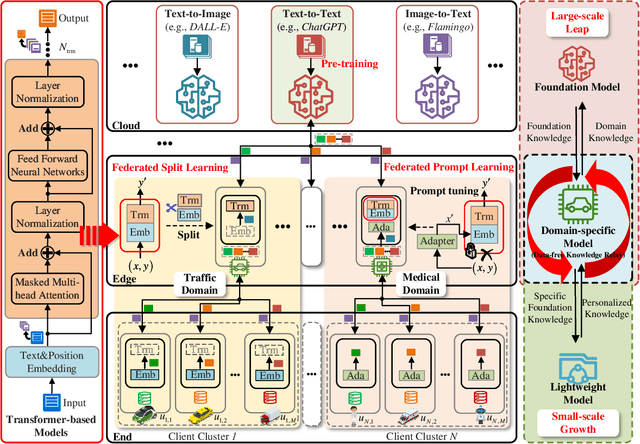
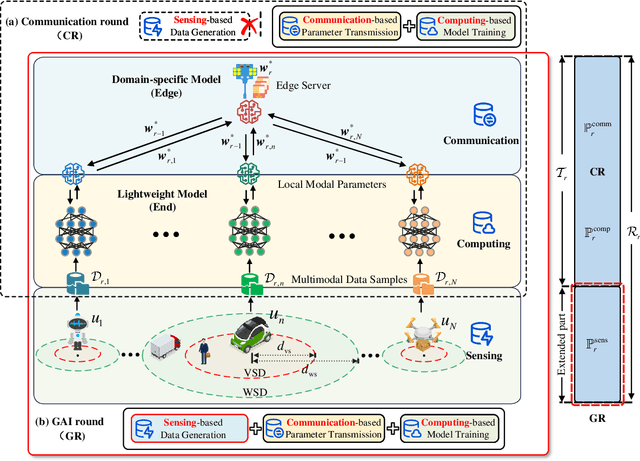
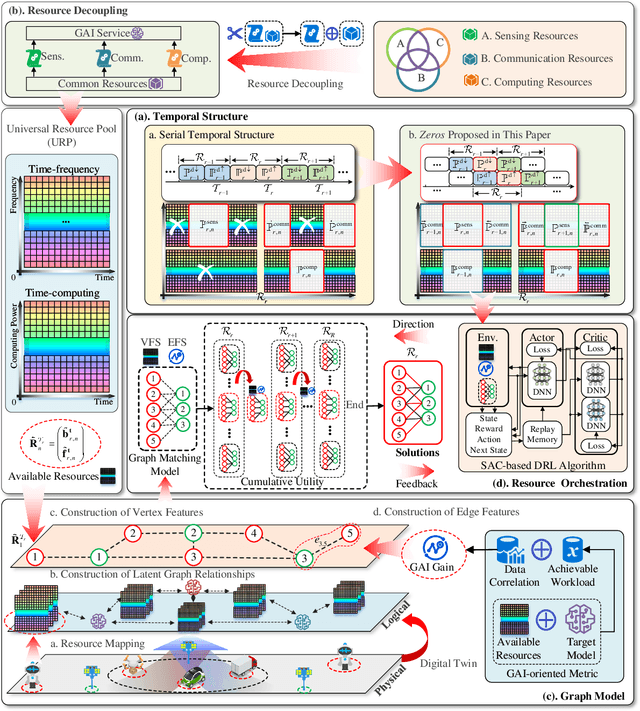
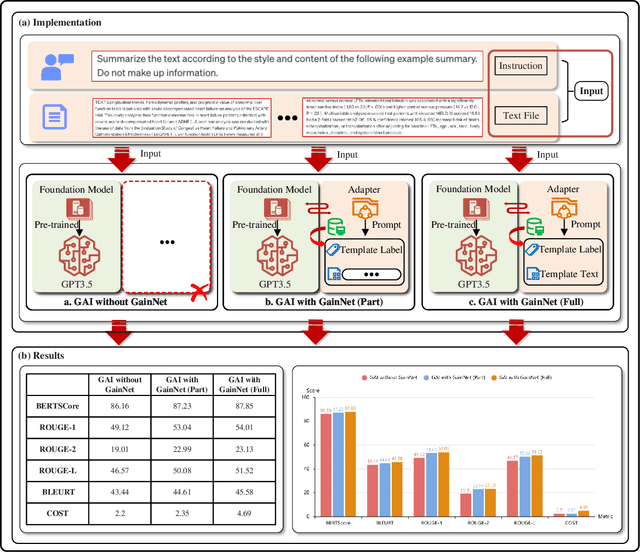
Abstract:The rapid expansion of AI-generated content (AIGC) reflects the iteration from assistive AI towards generative AI (GAI) with creativity. Meanwhile, the 6G networks will also evolve from the Internet-of-everything to the Internet-of-intelligence with hybrid heterogeneous network architectures. In the future, the interplay between GAI and the 6G will lead to new opportunities, where GAI can learn the knowledge of personalized data from the massive connected 6G end devices, while GAI's powerful generation ability can provide advanced network solutions for 6G network and provide 6G end devices with various AIGC services. However, they seem to be an odd couple, due to the contradiction of data and resources. To achieve a better-coordinated interplay between GAI and 6G, the GAI-native networks (GainNet), a GAI-oriented collaborative cloud-edge-end intelligence framework, is proposed in this paper. By deeply integrating GAI with 6G network design, GainNet realizes the positive closed-loop knowledge flow and sustainable-evolution GAI model optimization. On this basis, the GAI-oriented generic resource orchestration mechanism with integrated sensing, communication, and computing (GaiRom-ISCC) is proposed to guarantee the efficient operation of GainNet. Two simple case studies demonstrate the effectiveness and robustness of the proposed schemes. Finally, we envision the key challenges and future directions concerning the interplay between GAI models and 6G networks.
Integrated Sensing, Communication, and Computing for Cost-effective Multimodal Federated Perception
Nov 07, 2023Abstract:Federated learning (FL) is a classic paradigm of 6G edge intelligence (EI), which alleviates privacy leaks and high communication pressure caused by traditional centralized data processing in the artificial intelligence of things (AIoT). The implementation of multimodal federated perception (MFP) services involves three sub-processes, including sensing-based multimodal data generation, communication-based model transmission, and computing-based model training, ultimately relying on available underlying multi-domain physical resources such as time, frequency, and computing power. How to reasonably coordinate the multi-domain resources scheduling among sensing, communication, and computing, therefore, is crucial to the MFP networks. To address the above issues, this paper investigates service-oriented resource management with integrated sensing, communication, and computing (ISCC). With the incentive mechanism of the MFP service market, the resources management problem is redefined as a social welfare maximization problem, where the idea of "expanding resources" and "reducing costs" is used to improve learning performance gain and reduce resource costs. Experimental results demonstrate the effectiveness and robustness of the proposed resource scheduling mechanisms.
Sparsity-Aware Intelligent Massive Random Access Control in Open RAN: A Reinforcement Learning Based Approach
Mar 05, 2023



Abstract:Massive random access of devices in the emerging Open Radio Access Network (O-RAN) brings great challenge to the access control and management. Exploiting the bursting nature of the access requests, sparse active user detection (SAUD) is an efficient enabler towards efficient access management, but the sparsity might be deteriorated in case of uncoordinated massive access requests. To dynamically preserve the sparsity of access requests, a reinforcement-learning (RL)-assisted scheme of closed-loop access control utilizing the access class barring technique is proposed, where the RL policy is determined through continuous interaction between the RL agent, i.e., a next generation node base (gNB), and the environment. The proposed scheme can be implemented by the near-real-time RAN intelligent controller (near-RT RIC) in O-RAN, supporting rapid switching between heterogeneous vertical applications, such as mMTC and uRLLC services. Moreover, a data-driven scheme of deep-RL-assisted SAUD is proposed to resolve highly complex environments with continuous and high-dimensional state and action spaces, where a replay buffer is applied for automatic large-scale data collection. An actor-critic framework is formulated to incorporate the strategy-learning modules into the near-RT RIC. Simulation results show that the proposed schemes can achieve superior performance in both access efficiency and user detection accuracy over the benchmark scheme for different heterogeneous services with massive access requests.
Hybrid Architectures for Distributed Machine Learning in Heterogeneous Wireless Networks
Jun 04, 2022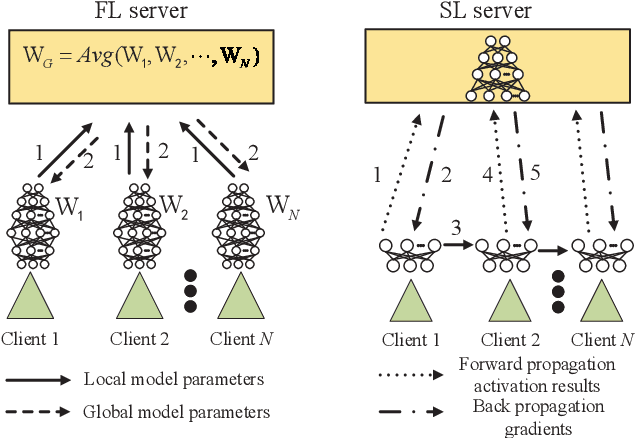
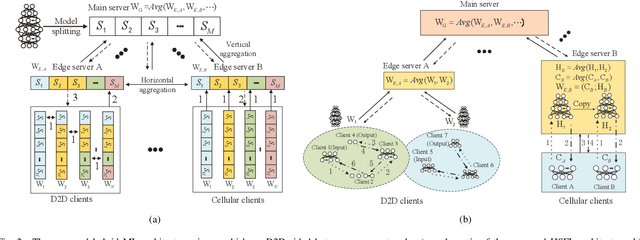

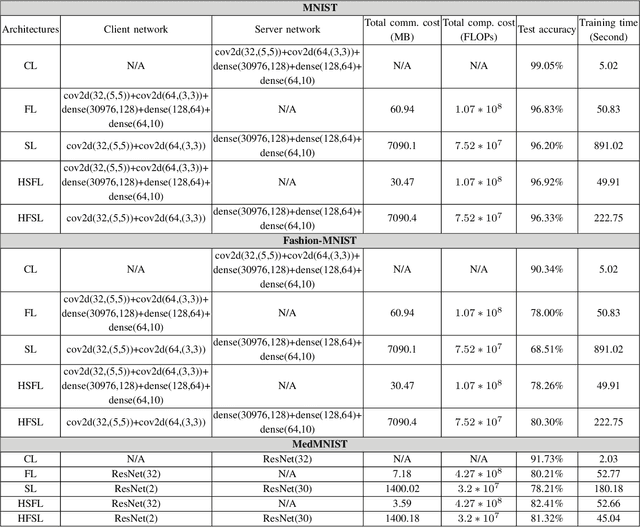
Abstract:The ever-growing data privacy concerns have transformed machine learning (ML) architectures from centralized to distributed, leading to federated learning (FL) and split learning (SL) as the two most popular privacy-preserving ML paradigms. However, implementing either conventional FL or SL alone with diverse network conditions (e.g., device-to-device (D2D) and cellular communications) and heterogeneous clients (e.g., heterogeneous computation/communication/energy capabilities) may face significant challenges, particularly poor architecture scalability and long training time. To this end, this article proposes two novel hybrid distributed ML architectures, namely, hybrid split FL (HSFL) and hybrid federated SL (HFSL), by combining the advantages of both FL and SL in D2D-enabled heterogeneous wireless networks. Specifically, the performance comparison and advantages of HSFL and HFSL are analyzed generally. Promising open research directions are presented to offer commendable reference for future research. Finally, primary simulations are conducted upon considering three datasets under non-independent and identically distributed settings, to verify the feasibility of our proposed architectures, which can significantly reduce communication/computation cost and training time, as compared with conventional FL and SL.
A Practical Cross-Device Federated Learning Framework over 5G Networks
Apr 18, 2022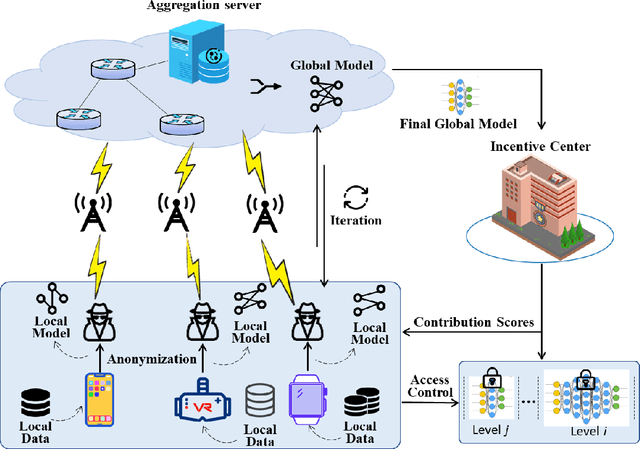
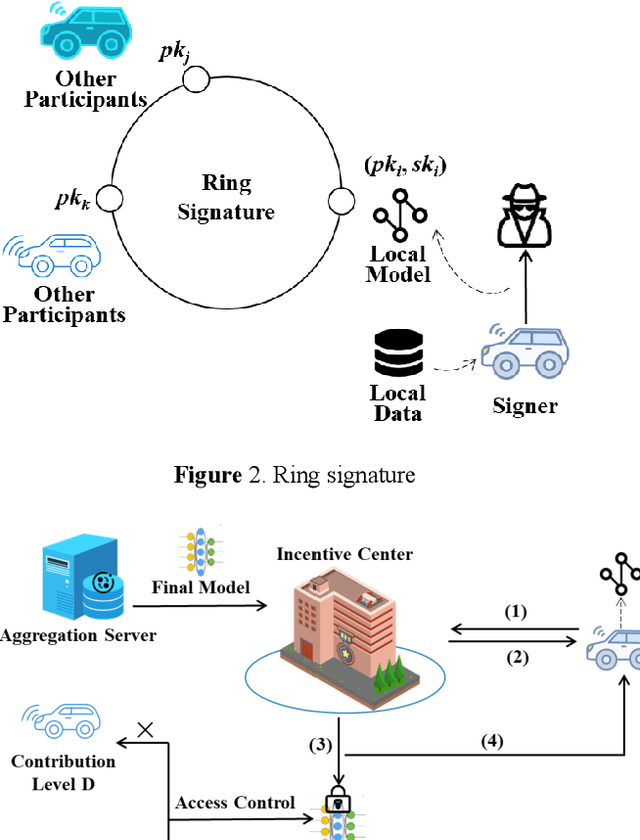
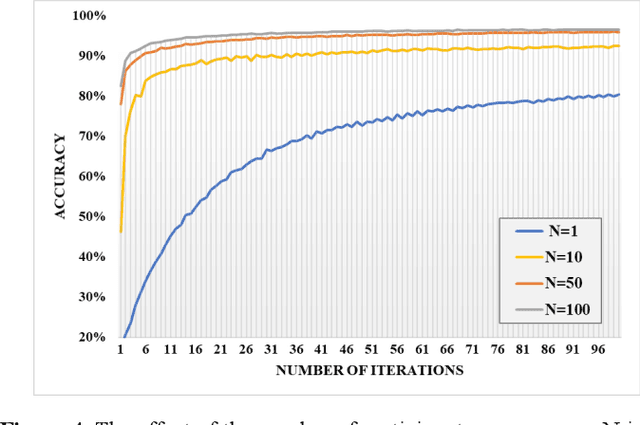
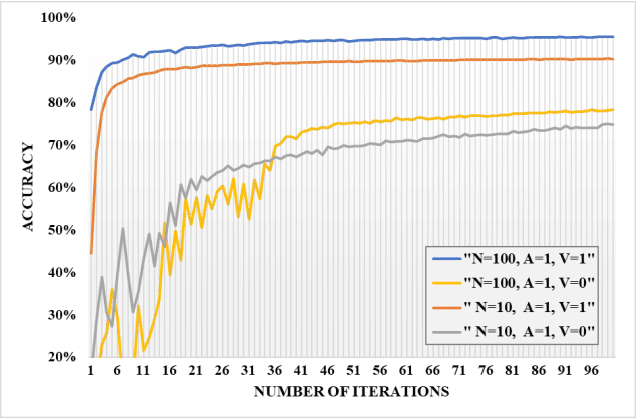
Abstract:The concept of federated learning (FL) was first proposed by Google in 2016. Thereafter, FL has been widely studied for the feasibility of application in various fields due to its potential to make full use of data without compromising the privacy. However, limited by the capacity of wireless data transmission, the employment of federated learning on mobile devices has been making slow progress in practical. The development and commercialization of the 5th generation (5G) mobile networks has shed some light on this. In this paper, we analyze the challenges of existing federated learning schemes for mobile devices and propose a novel cross-device federated learning framework, which utilizes the anonymous communication technology and ring signature to protect the privacy of participants while reducing the computation overhead of mobile devices participating in FL. In addition, our scheme implements a contribution-based incentive mechanism to encourage mobile users to participate in FL. We also give a case study of autonomous driving. Finally, we present the performance evaluation of the proposed scheme and discuss some open issues in federated learning.
Robust Attacks on Deep Learning Face Recognition in the Physical World
Nov 27, 2020



Abstract:Deep neural networks (DNNs) have been increasingly used in face recognition (FR) systems. Recent studies, however, show that DNNs are vulnerable to adversarial examples, which can potentially mislead the FR systems using DNNs in the physical world. Existing attacks on these systems either generate perturbations working merely in the digital world, or rely on customized equipments to generate perturbations and are not robust in varying physical environments. In this paper, we propose FaceAdv, a physical-world attack that crafts adversarial stickers to deceive FR systems. It mainly consists of a sticker generator and a transformer, where the former can craft several stickers with different shapes and the latter transformer aims to digitally attach stickers to human faces and provide feedbacks to the generator to improve the effectiveness of stickers. We conduct extensive experiments to evaluate the effectiveness of FaceAdv on attacking 3 typical FR systems (i.e., ArcFace, CosFace and FaceNet). The results show that compared with a state-of-the-art attack, FaceAdv can significantly improve success rate of both dodging and impersonating attacks. We also conduct comprehensive evaluations to demonstrate the robustness of FaceAdv.
SFE-GACN: A Novel Unknown Attack Detection Method Using Intra Categories Generation in Embedding Space
Apr 12, 2020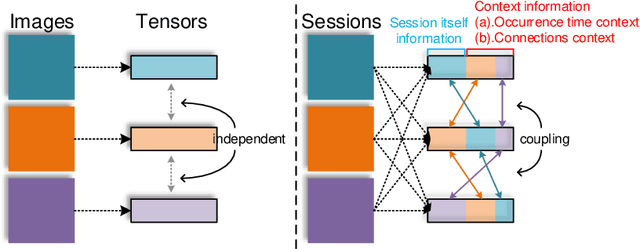

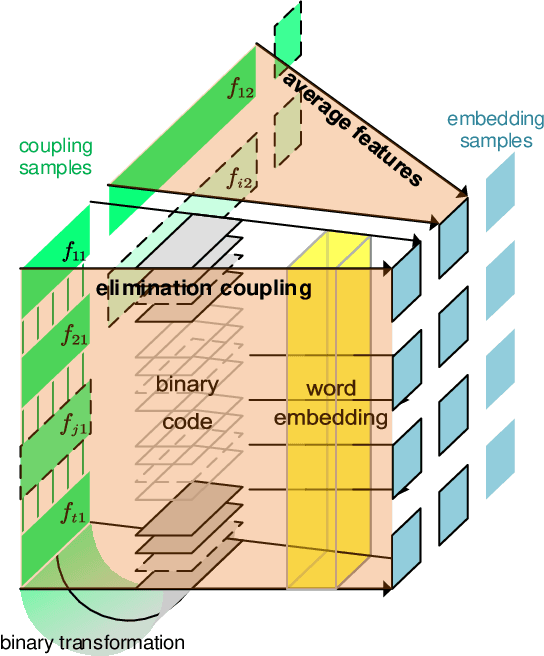

Abstract:In the encrypted network traffic intrusion detection, deep learning based schemes have attracted lots of attention. However, in real-world scenarios, data is often insufficient (few-shot), which leads to various deviations between the models prediction and the ground truth. Consequently, downstream tasks such as unknown attack detection based on few-shot will be limited by insufficient data. In this paper, we propose a novel unknown attack detection method based on Intra Categories Generation in Embedding Space, namely SFE-GACN, which might be the solution of few-shot problem. Concretely, we first proposed Session Feature Embedding (SFE) to summarize the context of sessions (session is the basic granularity of network traffic), bring the insufficient data to the pre-trained embedding space. In this way, we achieve the goal of preliminary information extension in the few-shot case. Second, we further propose the Generative Adversarial Cooperative Network (GACN), which improves the conventional Generative Adversarial Network by supervising the generated sample to avoid falling into similar categories, and thus enables samples to generate intra categories. Our proposed SFE-GACN can accurately generate session samples in the case of few-shot, and ensure the difference between categories during data augmentation. The detection results show that, compared to the state-of-the-art method, the average TPR is 8.38% higher, and the average FPR is 12.77% lower. In addition, we evaluated the graphics generation capabilities of GACN on the graphics dataset, the result shows our proposed GACN can be popularized for generating easy-confused multi-categories graphics.
Self-Selective Correlation Ship Tracking Method for Smart Ocean System
Feb 26, 2019



Abstract:In recent years, with the development of the marine industry, navigation environment becomes more complicated. Some artificial intelligence technologies, such as computer vision, can recognize, track and count the sailing ships to ensure the maritime security and facilitates the management for Smart Ocean System. Aiming at the scaling problem and boundary effect problem of traditional correlation filtering methods, we propose a self-selective correlation filtering method based on box regression (BRCF). The proposed method mainly include: 1) A self-selective model with negative samples mining method which effectively reduces the boundary effect in strengthening the classification ability of classifier at the same time; 2) A bounding box regression method combined with a key points matching method for the scale prediction, leading to a fast and efficient calculation. The experimental results show that the proposed method can effectively deal with the problem of ship size changes and background interference. The success rates and precisions were higher than Discriminative Scale Space Tracking (DSST) by over 8 percentage points on the marine traffic dataset of our laboratory. In terms of processing speed, the proposed method is higher than DSST by nearly 22 Frames Per Second (FPS).
Super-Resolution of Brain MRI Images using Overcomplete Dictionaries and Nonlocal Similarity
Feb 13, 2019



Abstract:Recently, the Magnetic Resonance Imaging (MRI) images have limited and unsatisfactory resolutions due to various constraints such as physical, technological and economic considerations. Super-resolution techniques can obtain high-resolution MRI images. The traditional methods obtained the resolution enhancement of brain MRI by interpolations, affecting the accuracy of the following diagnose process. The requirement for brain image quality is fast increasing. In this paper, we propose an image super-resolution (SR) method based on overcomplete dictionaries and inherent similarity of an image to recover the high-resolution (HR) image from a single low-resolution (LR) image. We explore the nonlocal similarity of the image to tentatively search for similar blocks in the whole image and present a joint reconstruction method based on compressive sensing (CS) and similarity constraints. The sparsity and self-similarity of the image blocks are taken as the constraints. The proposed method is summarized in the following steps. First, a dictionary classification method based on the measurement domain is presented. The image blocks are classified into smooth, texture and edge parts by analyzing their features in the measurement domain. Then, the corresponding dictionaries are trained using the classified image blocks. Equally important, in the reconstruction part, we use the CS reconstruction method to recover the HR brain MRI image, considering both nonlocal similarity and the sparsity of an image as the constraints. This method performs better both visually and quantitatively than some existing methods.
 Add to Chrome
Add to Chrome Add to Firefox
Add to Firefox Add to Edge
Add to Edge